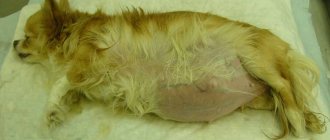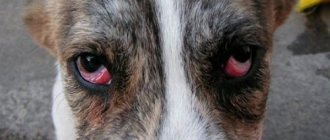A dog's pulse is normal at a frequency of 70-110 in large breeds, 80-120 in small breeds and up to 150-180 beats per minute for puppies. When the deceleration is below normal, bradycardia occurs with general weakness, and there may be a fainting state. When accelerated, a diagnosis of tachycardia is made; its cause is infection, heart failure, and hormonal imbalances. If the pulse is irregular, there are fluctuations from frequent to rare, interruptions, then this is called arrhythmia.
In order to normalize the heart rate, you need to consult a veterinarian. He conducts ECG, ultrasound, tests to identify the cause of the rhythm disturbance. Then you need to undergo treatment for the underlying disease, after which the normal pulse will be restored.
Dog pulse: normal for large breeds
For large breed dogs, the normal heart rate approaches the human heart rate - at rest 70-110, and during physical activity it increases to 140-160 beats per minute. This is typical for:
- labrador retriever,
- golden retriever,
- German Shepherd.
For older animals, the norm is 10-15 strokes lower. The heart beats at approximately the same frequency in dogs weighing more than 50 kg (very large breeds) - malamute, great dane, wolfhound.
Emergency criteria
• Deviation in behavior and activity.
First of all, you may notice deviations in the general condition of your pet, in the form of decreased activity (depression, lethargy) or unusual behavior. The most common symptom in an emergency situation is general depression, fatigue after light or moderate physical activity, and reluctant movement. The head is lowered, the tail is tucked. Instead of oppression there can be excitement. Aggression or fear often indicates that the animal is in pain.
• Airway obstruction.
In dogs that are not brachycephalic breeds (those with a “flattened muzzle”), breathing should not be noisy, either with the mouth open or closed.
If you hear your pet breathing, it is possible that he has an obstructed upper airway, for example due to a foreign body blockage, a pathological mass (such as a tumor), or swelling of the pharynx or larynx. • Breathing problems.
Visible effort during inhalation and/or exhalation indicates an emergency condition, especially if the animal is breathing with its mouth open. Breathing disorders due to diseases of the respiratory system may be less obvious. For example, you may only notice rapid breathing, not accompanied by any special effort. • Poor circulation.
Any circulatory disorders are usually accompanied by changes in several parameters of the body. For example, changes in the color of mucous membranes, pulse, heart rate and capillary refill rate can be simultaneously observed.
Heartbeats may be excessively frequent or, conversely, rare. You can determine if there are any abnormalities only by knowing your pet's normal heart rate. In most cases, acceleration or deceleration of heartbeats is combined with a change in the general condition of the animal, the color of the mucous membranes and the time of capillary refilling.
The pulse can also be rapid or too rare. In addition, it can be consistently weak, or vary in the filling of blood vessels. In circulatory disorders, the pulse beats usually lag behind the heart beats, which can be determined by simultaneously monitoring the pulse and heartbeats.
An increase in capillary refill time indicates deterioration of blood flow. If the capillary refill time exceeds 2 seconds, the animal should be shown to a veterinarian. An indicator of less than 1 second in dogs with intensely pink mucous membranes may also indicate a pathology that requires examination.
Typically, an increase in capillary refill time is combined with a rapid or slow heartbeat. If the animal's mucous membranes look too pale or white, the animal should be shown to a veterinarian. An animal with any disturbances in activity, breathing or circulation needs immediate first aid and transportation to a veterinarian.
Temperature, pulse, breathing in dogs are normal
The parameters of temperature, pulse and respiration are interrelated; their parameters in dogs normally depend on the breed (see table).
| Index | Small breeds | Medium breeds | Large breeds |
| Temperature in degrees Celsius | 38-39 | 37,5-39 | 37,4-38,3 |
| Pulse rate, beats per minute | 80-120 | 85-115 | 70-110 |
| Number of breathing cycles per minute | 15-30 | 10-25 | 7-20 |
| Temperature/pulse/breathing of the puppy | 39/160/80 | 38,7/140/60 | 38,2/120/50 |
Outside of diseases, these indicators are affected by:
- food,
- physical activity,
- exposure to the sun,
- ambient temperature,
- pregnancy,
- excited state
- fear.
Heart rate characteristics
If you monitor the number of heartbeats, you can determine the general state of the animal’s blood circulation. There are several factors in the pulse pattern that affect a dog’s health:
- tension;
- rhythm;
- frequency;
- filling;
- form;
- size.
Let's consider each of the factors in more detail.
What Causes Heart Rate Changes in Dogs?
Changes in heart rate in dogs are associated with heart disease and non-cardiac pathologies. Even before a visit to the veterinarian, the owner himself can detect deviations from the norm (irregular, frequent, rare, weak), but only a veterinarian can determine their cause.
Ari class=”aligncenter” width=”607″ height=”379″[/img]
Arrhythmia in a dog is a disturbance in the rhythm of heart contractions, which can manifest itself in acceleration (tachycardia), deceleration (bradycardia), or interruptions. Heart rate fluctuations are also possible - periodic acceleration and deceleration. Arrhythmia can occur with a normal, but extremely weak – thread-like pulse.
Heart rhythm disturbances occur due to:
- overheating, hypothermia;
- lack of food, water;
- diseases of the cardiovascular, pulmonary and digestive systems;
- kidney dysfunction;
- tumor processes;
- infections.
In a dog, arrhythmia manifests itself in the form of low activity, rapid fatigue, heavy and noisy breathing, and sudden loss of consciousness.
Bradycardia
Bradycardia is a slow heart rate. It can be caused by:
- poisoning, including medications, chemicals, nicotine;
- physical or stressful overexertion;
- heart pathologies with circulatory disorders;
- hypothermia;
- starvation;
- infectious diseases;
- bleeding due to injury, from a disintegrating tumor;
- traumatic brain injury;
- vascular diseases of the brain;
- high intracranial pressure;
- viral hepatitis, liver cirrhosis.
A slowing of the pulse leads to severe weakness of the animal, impaired walking, convulsive muscle twitching, and fainting.
Tachycardia
Tachycardia in a dog is an increase in heart rate above average. It happens in the background:
- heart and lung failure;
- ischemia, myocardial infarction;
- high blood pressure;
- inflammation of the lungs, inner or muscular layer of the heart, stomach;
- tumors;
- increased function of the thyroid gland, adrenal glands;
- diabetes.
Symptoms of a rapid pulse may include weakness, poor appetite, noisy and heavy breathing, and cough.
Thready pulse
A thread-like pulse is rapid and weak, typical of severe shock conditions. Provoking factors may be allergies, a drop in cardiac output due to inflammation or ischemia (myocarditis, heart attack).
Causes of increased heart rate
An increased heart rate is not always a consequence of the presence of a disease. Tachycardia will be observed after active games and jogging. The rhythm accelerates if the dog is frightened by something or is in a state of stress. If there are no natural causes for tachycardia, and an increase in heart rate is observed regularly, this may be a consequence of:
- diseases of the cardiovascular system;
- malignant tumors in the respiratory system;
- inflammatory processes;
- disruptions in the functioning of the endocrine system.
Increased heart rate is observed in coronary artery disease, arterial hypertension, and myocardial infarction. This disorder can appear during endometritis, pneumonia, and inflammation in the heart tissues. It is one of the symptoms of diabetes and hyperthyroidism. With regular tachycardia, it is necessary to have the dog examined at a veterinary hospital.
How to check a dog's pulse, where to measure it
You can check your dog’s pulse at the femoral artery; to measure it, you need to:
- Wrap your hand around the back paw closer to the stomach.
- The thumb should be on the outside, and the other four should be on the inside.
- Carefully feel the pulsation of the artery with your fingertips.
- Start the stopwatch for one minute and count the number of beats.
It is better for the dog to stand while doing this; it can be more difficult to find the pulse of a lying animal. If you are very excited, you can count the beats in 15 seconds and multiply by 4. You should not determine your pulse immediately after a walk or meal; a rest period of at least 10 minutes is necessary.
Diseases of the upper respiratory tract, larynx, trachea
Symptoms of diseases of the upper respiratory tract, larynx and trachea differ from diseases of other parts of the respiratory system due to noisy breathing. Mainly while inhaling.
During inhalation, the muscles of the chest and abdomen in such patients work hard to draw air into the lungs. When expanding, the chest noticeably increases in volume, and the walls of the abdominal cavity “fall inward.”
While inhaling, the dog may open its mouth and experience obvious difficulty breathing. The animal looks restless. There may be an increase in temperature as a result of impaired thermoregulation. An increase in temperature, in turn, worsens shortness of breath. Gums are pale, white or bluish. Foreign body in the upper respiratory tract, pharynx or trachea.
Dogs love to play with foreign objects that are convenient to hold in their mouths. During play, such an object can slip into the throat and block its lumen. This condition is life-threatening. Emergency assistance required.
If a foreign body is visible in the lumen of the pharynx: • do not try to remove the object with your fingers; • It is necessary to apply the Heimlich maneuver: If the dog is conscious: from the side of the animal’s back, put your arms around its waist. Make a fist with one hand and place your thumb on your stomach, in the middle, just above your navel. With your other hand, clasp your fist tightly with your hand. Next, with sharp jerking movements of both hands, you need to press on the abdominal area several times in a row. If the technique is effective and the foreign body has advanced into the oral cavity, you will hear a deep breath and a convulsive cough.
• please note that the Heimlich maneuver should only be used when the foreign body is visible; • the use of this method in case of other causes of difficulty breathing may harm the animal; • incorrect execution can harm the dog; • after removing a foreign body using this method, you must show the animal to a doctor. • If the efforts do not lead to success, the animal loses consciousness, the mucous membranes begin to turn blue, it is necessary to immediately turn the animal over a bent knee, head down on its stomach, and hit the interscapular area with the palm of the hand several times. If a foreign object then moves into the oral cavity, remove it (provided you can see it!) • While providing assistance, you must call a veterinarian or go to a veterinary clinic.
How to normalize a dog's heartbeat
To normalize a dog's heartbeat, it is necessary to find out the cause of the arrhythmia. To do this, contact a veterinarian, he examines the dog, prescribes an ECG, ultrasound of the heart, kidneys, liver, chest x-ray, blood and urine tests.
In order to prevent arrhythmia, sufficient physical activity and long walks in nature are recommended. The animal's diet should contain protein, vitamins and minerals. Owners of dogs with a tendency to heart disease (poodle, fox terrier, St. Bernard, Doberman) are recommended to take the animal for annual preventive examinations.
A dog’s heart should beat rhythmically and at a frequency that corresponds to the norm, but more objective signs of an animal’s health are its activity, appetite, and exercise tolerance. If any indicator worsens, you should contact your veterinarian.
The pulse of a healthy dog is rhythmic, its frequency should be within the average norm, it is different for animals of small and large breeds, puppies. If rhythm disturbances are detected, it is necessary to establish the cause and undergo treatment for the underlying disease.
Signs of a sick dog
To prevent any disease, maintaining immunity is extremely important.
The main factors influencing immunity are the physical well-being of the animal, its mental and physiological state, and characteristics of the breed. Physical well-being refers to the comfortable conditions that determine the dog’s physical fitness. Some people think that it is difficult to diagnose a dog because he cannot tell what is hurting him. Indeed, the dog will not tell you about the symptoms, but it does not give out a lot of false information, as children do, for example, in order to avoid going to school.
Difficulties in diagnosis lie in the fact that many diseases have similar symptoms, and the symptoms of the same disease are not always the same. For example, fever, loss of appetite and weakness are signs of many diseases, and distemper has a wide variety of symptoms depending on which organs are affected.
Dogs, like people, have their off days. Sometimes they feel unwell for no apparent reason, so if your pet lies down all day, don't rush to diagnose it.
It should also be noted that dogs running freely outside often have mild gastric upsets, sometimes even vomiting, although they are in generally normal health. Therefore, do not attach much importance to such ailments, if, of course, they end happily.
From a practical point of view, symptoms can be divided into two types: observable, determined by simple techniques - measuring temperature and pulse, and detected only by laboratory methods - during chemical tests, microscopic examinations, etc.
Of other causes, the first place is severe injuries and tumors.
Magnitude, tension and content
High intensity of the pulse wave is easy to determine - the more difficult it is to squeeze the artery with your fingers until blood circulation through it stops, the higher the intensity.
The filling of the pulse is the amount of blood transferred in one impulse. The weaker the push, the less blood is driven.
The value is a criterion that combines the indicators of the previous two points. The higher the reading, the greater the value, which indicates heart valve insufficiency.
But if the value is large after physical exertion, then this is the norm, and this factor does not indicate illness.
Signs of the disease at different stages
Attentive dog owners may suspect the presence of the disease even in childhood. If at least 1 sign appears at a young age, then most likely we are talking about a congenital disease. In this case, the animal’s condition needs to be monitored for the puppy’s normal life and if there is the slightest change, consult a doctor. These may be sudden fainting, lethargy, constant sleep, refusal to eat, shortness of breath, blue mucous membranes. As an adult, the animal quickly gains weight, drinks a lot of water often, and coughs heavily. An elderly dog has swelling in the chest and paws, there is no appetite, the animal constantly wants to sleep and does not want to move.
- Healthy and sick dog
- Examination of the dog and determination of its condition
- Body temperature measurement
- Respiration rate determinations
- Counting heart beats and pulse
Chapter 1. Determining the dog's health status
Healthy and sick dog
A healthy dog is a cheerful animal with shiny, glossy fur, clean and clear eyes, and a slightly damp and cool nose. True, the last sign is not always reliable. A healthy dog responds to the owner’s call and willingly follows commands. A healthy dog has a good appetite, bowels are emptied regularly, and urination is normal. The mucous membranes of the mouth and eyelids are clean, pale pink. Breathing is smooth and correct.
A sick dog is noticeably different from a healthy one. Any disease causes a number of more or less serious disorders in her body.
A sick dog behaves differently than a healthy dog. She is depressed, lies down a lot, tries to hide in a dark place, and is reluctant to get up when called. In some diseases, the dog, on the contrary, does not want to lie down, stands for a long time and, only when completely exhausted, takes a forced lying down or other position. A sick dog is either indifferent to others, or abnormally excited, too active, and can be aggressive even towards people close to it.
The sick dog's appetite is impaired. In some cases, the dog eats poorly or refuses food altogether, in others, its appetite is increased or perverted. Swallowing solid food is difficult, and choking may occur when swallowing even liquid food. Increased thirst or, conversely, hydrophobia may occur.
The coat turns from shiny and glossy to dull and tousled. Baldness of certain areas of the body, rashes, scratching, non-healing wounds or eczema are possible.
The mucous membranes of the oral cavity and eyelids are pale, bluish or icteric.
The activity of the gastrointestinal tract is disrupted: this manifests itself in vomiting, diarrhea, constipation, accumulation of gases in the intestines, the presence of blood, foreign objects, and worms in the stool.
Purulent discharge appears from the nose, eyes and other organs of the sick dog.
Urination is disrupted, the color of urine and its quantity change.
Body temperature, pulse, and breathing may also deviate from the norm.
The listed signs of a sick dog usually do not appear at the same time; sometimes one or several are clearly expressed. But with a serious illness or with the development of a particular disease, the number of pathological manifestations increases. We can talk about the dog’s recovery only after the disappearance of all painful manifestations characteristic of a particular disease.
Examination of the dog and determination of its condition
Examination of a sick dog can begin with the coat and skin. To do this, you need to disassemble the fur and carefully examine the skin, as well as the hairless parts of the abdomen and the inner surfaces of the hind limbs (thighs). If you suspect the presence of skin parasites, you can use a magnifying glass.
Then it is determined whether there is any discharge from the eyes and other organs of the dog.
When examining the eye, gently pull the lower eyelid down with a finger. The mucous membrane of a dog's oral cavity is easy to examine. To do this, the upper lip from the side must be slightly curled upward. If you can open the mouth, it will be possible to examine the dog’s entire oral cavity, including mucous membranes, teeth, tongue, etc. Rice.
1. Examination of the eyes It is better to examine the cavity of the auricle and ear canal in good lighting. In dogs with floppy ears, you must first lift the ear and straighten the pinna.
The condition of the intestines (pain, overflow with gases, feces) is determined by palpating it through the peritoneum in the groin area, while it is best for the examiner to stand behind the dog. If the dog owner or dog trainer has certain skills, then in this way the degree of bladder filling can be determined.
The nature of natural physiological functions is noted while walking the dog.
Measuring body temperature, counting respiration and pulse will help to create a complete and accurate picture of the dog’s illness, which is extremely important for correct diagnosis and treatment.
Body temperature measurement
Measuring a dog’s body temperature using a veterinary or medical thermometer, as already mentioned, will make it possible to more accurately determine its condition.
Since there are not enough veterinary thermometers produced by the industry, dog owners use ordinary medical thermometers. Rice.
2. Measuring body temperature To measure the temperature, shake the thermometer so that the mercury drops to the bottom level, lubricate the end of the thermometer with Vaseline oil, take the dog in your arms, lay it on its side or stand it, lift the tail with your left hand and carefully insert the thermometer into the anus so that the reservoir of mercury (the tip of the thermometer) was located in the rectum. You need to hold the thermometer for 3 minutes. After measuring and recording the temperature, the thermometer is cleaned of feces, washed with warm water and soap, and disinfected. It is advisable to take temperature measurements at the same hours: in the morning - between 7-9 o'clock and in the evening - between 17-19 o'clock. A dog's normal body temperature is 37.5° - 39°C. Many dogs under 6 months of age have a normal temperature of 39.5°C.
Respiration rate determinations
The dog owner must also be able to determine the animal’s breathing rate, which is important both for identifying the disease and for treating respiratory complications.
The breathing rate can be determined by counting the number of inhalations or exhalations within one minute, using several techniques: by the movement of the dog’s chest and abdomen; by the movement of the wings of the nose; by placing the palms of the hands on the chest, which makes it possible to capture respiratory movements.
Normally, the number of inhalations and exhalations (breathing) in a healthy dog varies within significant limits: from 14 to 25-30 per minute. This breadth of the respiratory rate range depends on a number of factors. For example, puppies breathe more often than adult dogs because their metabolism is more active. Bitches breathe more frequently than males. Pregnant or nursing dogs breathe more frequently than non-pregnant dogs. The breathing rate can also be affected by the breed of the dog and its emotional state. The growth of the dog also has a noticeable effect on breathing. Dogs of small breeds breathe more often than large ones: the Miniature Pinscher and Japanese Chin breathe 20-25 times per minute, and the Airedale - 10-14 times. This is understandable. Dogs of small decorative breeds have a more active metabolic process and as a result there is a greater loss of heat.
Breathing largely depends on the dog’s body position. Animals breathe easier when they stand. In case of diseases accompanied by damage to the heart and respiratory organs, animals take a sitting position, which helps to facilitate breathing.
The breathing process is also affected by the time of day and season. At night, when at rest, the dog breathes less frequently. In summer, when the weather is hot, as well as in stuffy apartments with high humidity, breathing becomes more frequent. In winter, dogs' breathing at rest is even and imperceptible.
Muscle work sharply increases the dog's breathing.
The factor of the animal's excitability is also of certain importance. The appearance of a stranger or a new environment can cause rapid breathing.
What conclusion can be drawn from all of the above? An increase in the number of respiratory movements in a dog can be considered the result of a deviation from the norm only when it is not explained by the reasons listed above and lasts for a long time.
Counting heart beats and pulse
In addition to measuring the temperature and counting the respiratory rate, to determine the disease in the dog, you should also count the heart beats and pulse.
The heartbeat can be easily felt by placing your palm on the left side of the dog's chest, just below the shoulder blade. In small breed dogs, the heartbeat can also be felt on the right side of the chest.
The pulse can be counted on the inner thigh by placing your fingers on the femoral artery.
In small breed dogs, the femoral artery is felt under the fingers in the form of a finely pulsating thread, in large breed dogs it is felt in the form of a cord. Rice. 3. Counting heart beats Fig.
4. Pulse counting The number of pulse beats per minute in dogs ranges from 70 to 120. This has its reasons. Young dogs have a faster heart rate than older dogs. Males have a slower pulse than females.
With stuffiness, heat, muscle strain, and emotional disturbances, the pulse quickens.
In diseases accompanied by fever, breathing and pulse also increase.
Table of contents
Acute and chronic heart failure: differences
Acute heart failure (AHF) . Its main difference is its high speed of development. In dogs, it develops against the background of large blood loss, severe infectious diseases, etc. In addition, it can occur at some stages of chronic heart failure (CHF). In case of AHF, emergency first aid by professionals is required. Only in a veterinary clinic will it be possible to relieve the pet’s acute condition.
Chronic heart failure (CHF) . Among the most common reasons: hormonal imbalances and excessive physical activity that does not correspond in intensity to the animal’s body weight. The main difference is the slow and constant increase in clinical signs over several months or even years. All symptoms manifest themselves in stages: from breathing problems to ascites. In addition, chronic heart failure is characterized by severe exhaustion of the pet.
Treatment of heart failure
Timely contact with veterinarians is the key to effective treatment. When an animal arrives, the veterinarian first assesses the condition of its body. If urgent stabilization is required for acute heart failure, then emergency measures are taken.
Treatment tactics are based on eliminating the cause that provokes the development of the disease (for example, heartworms, congenital heart muscle defects, etc.), as well as controlling emerging clinical signs.
To carry out effective drug therapy, experts prescribe:
- Angiotensin-converting enzyme (ACE) inhibitors. They eliminate spasms, normalize blood pressure, improve the supply of oxygen to the myocardium, and also dilate the heart arteries;
- Beta blockers . They are prescribed to achieve hypotensive and antiarrhythmic effects. Drugs in this group improve myocardial perfusion. They are prescribed to pets when sinus rhythm is detected;
- Symptomatic drugs . Their intake is necessary to eliminate the clinical manifestations of heart failure. Veterinarians prescribe diuretics, cardiotropics, painkillers and other medications.











